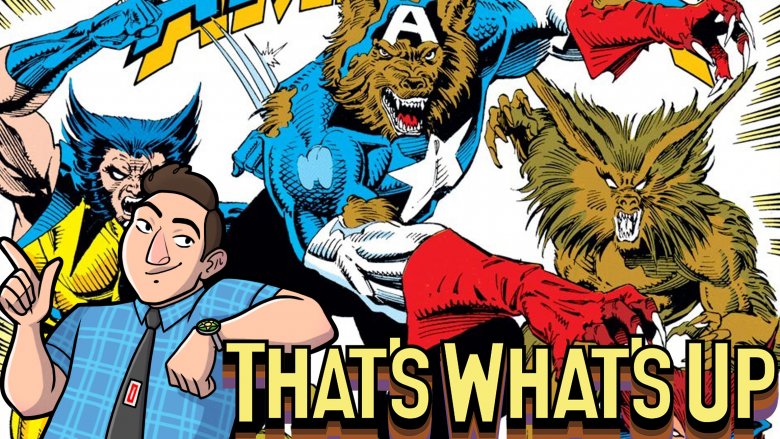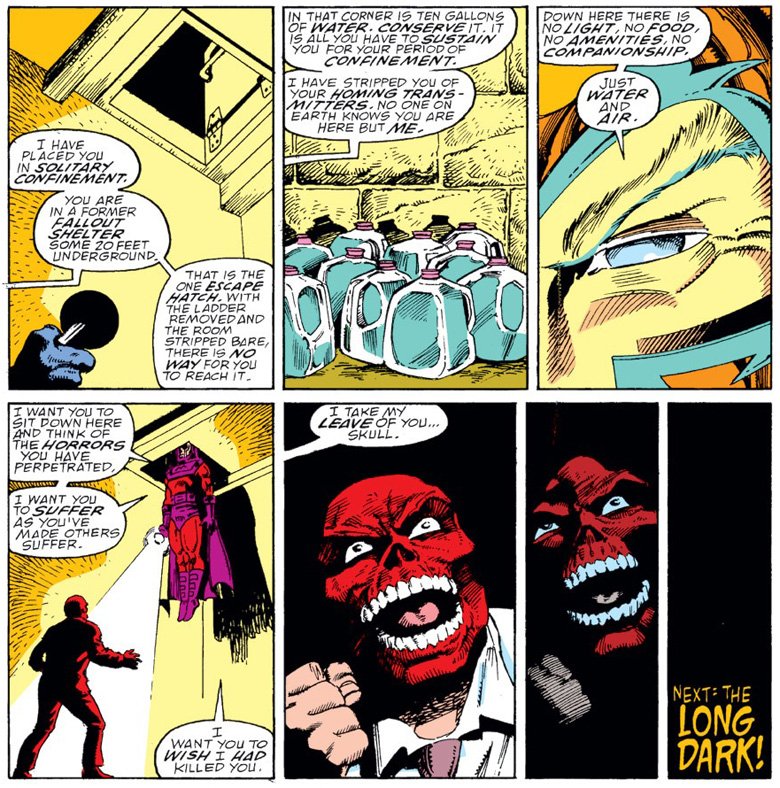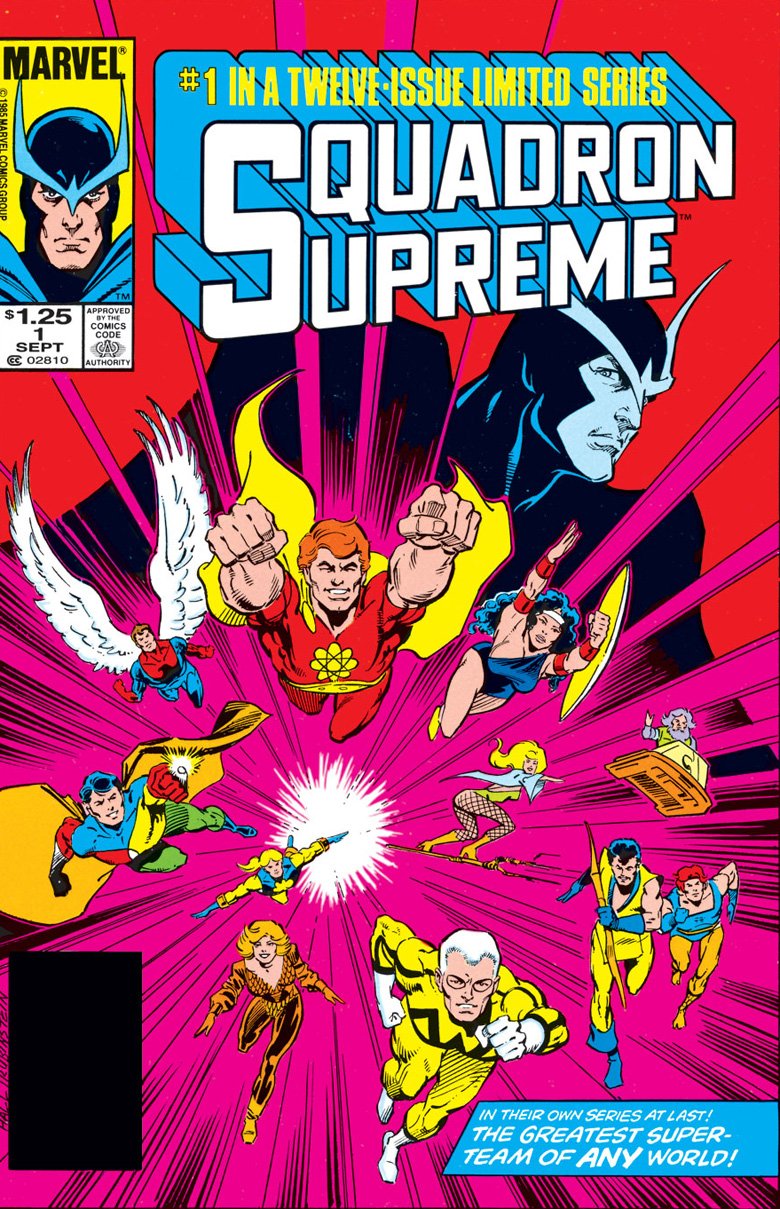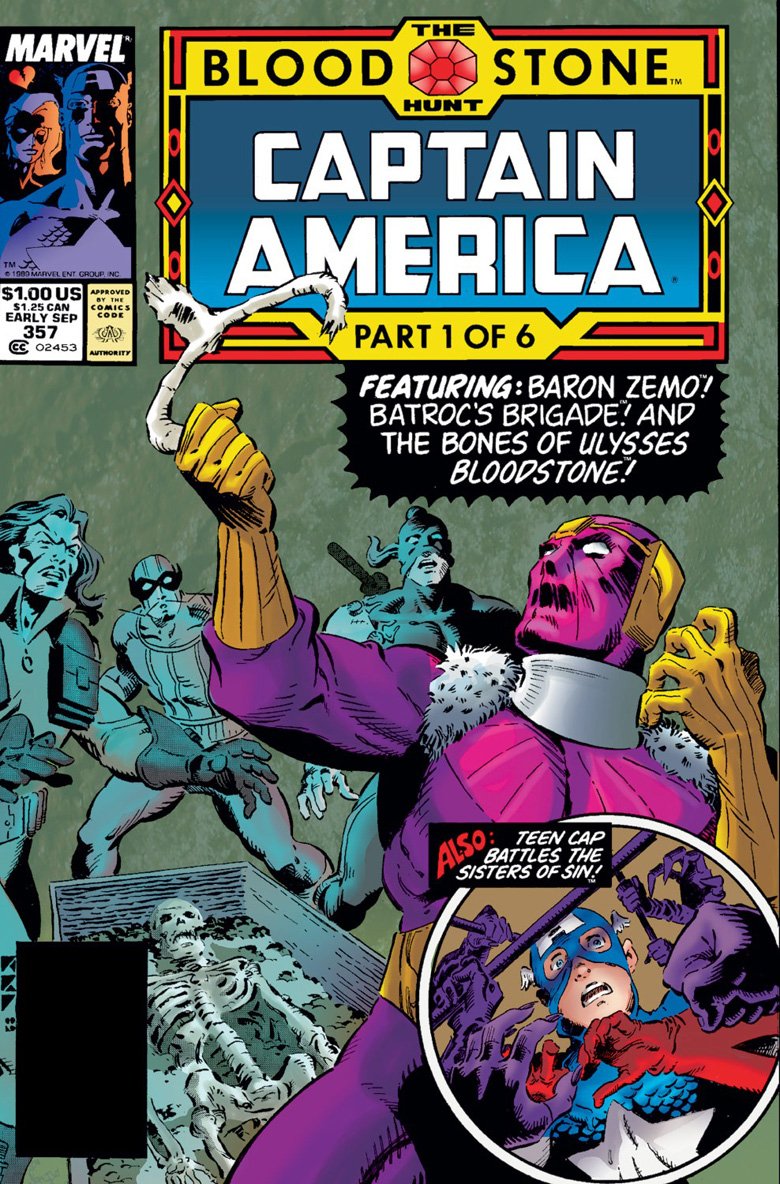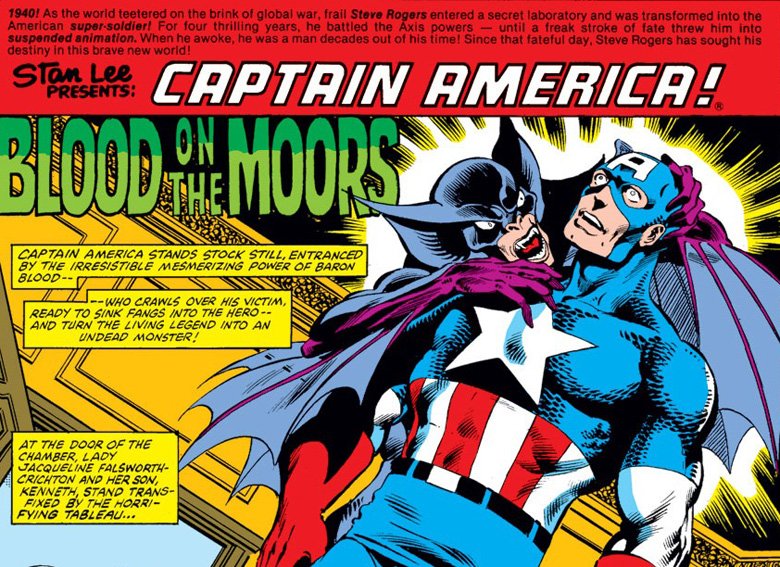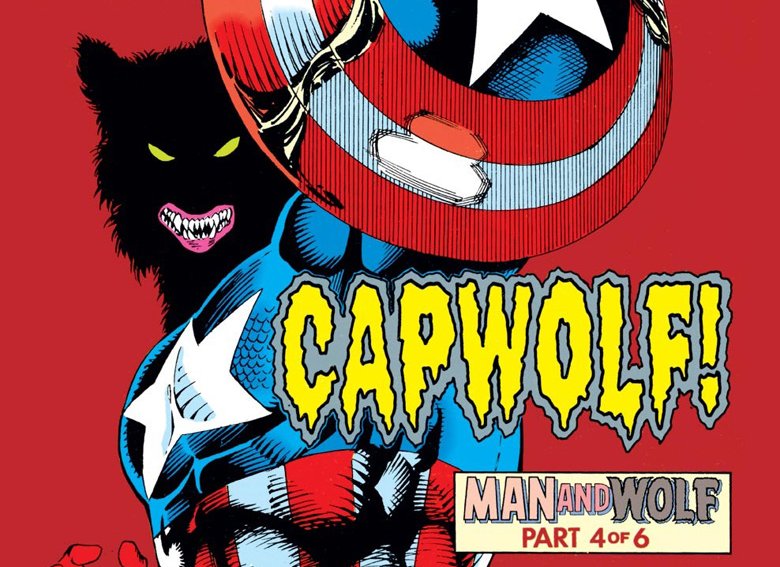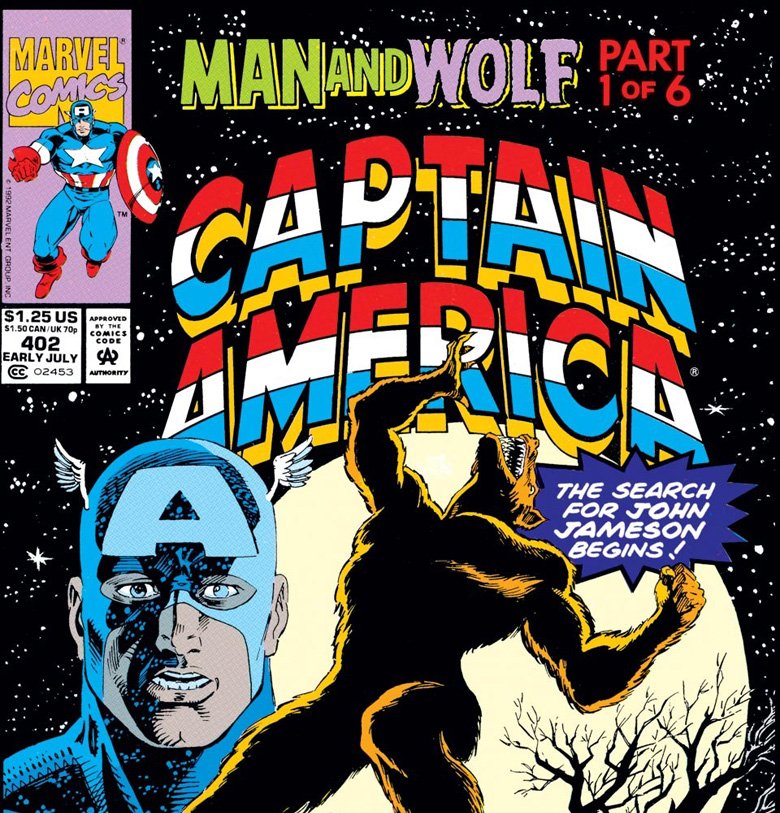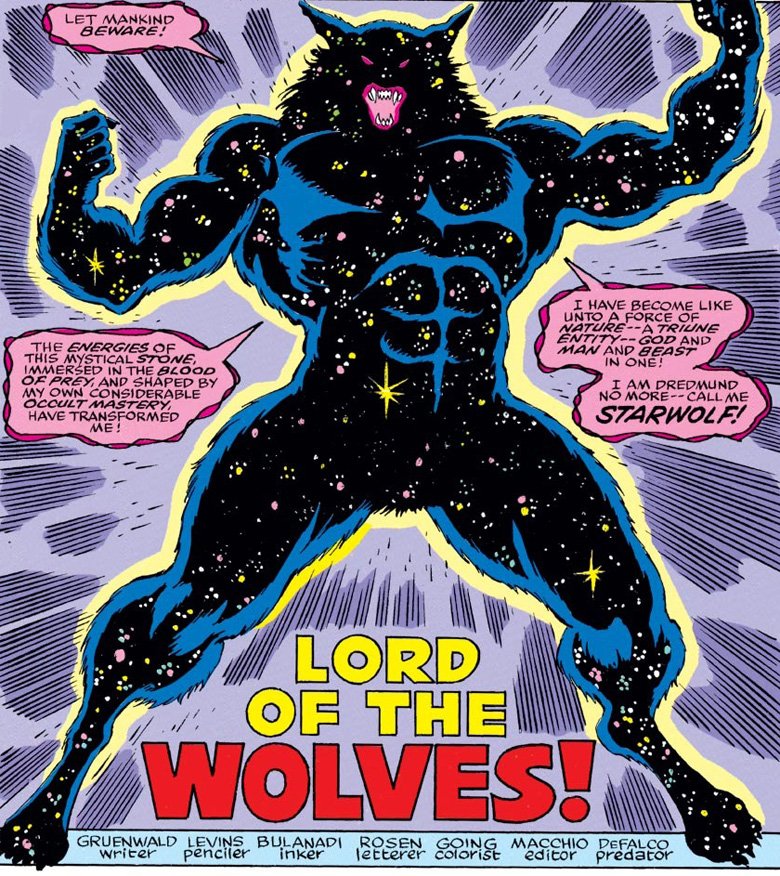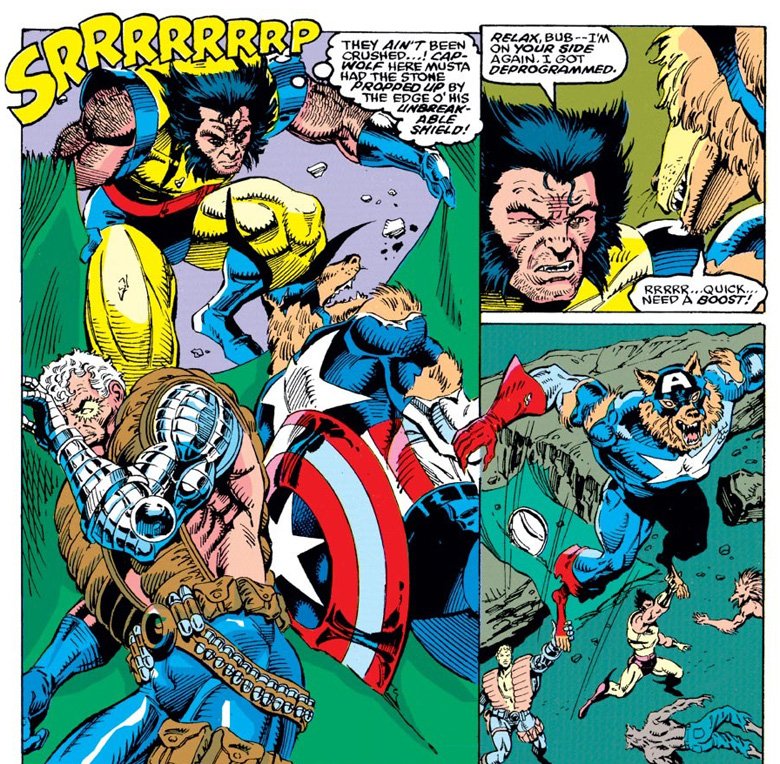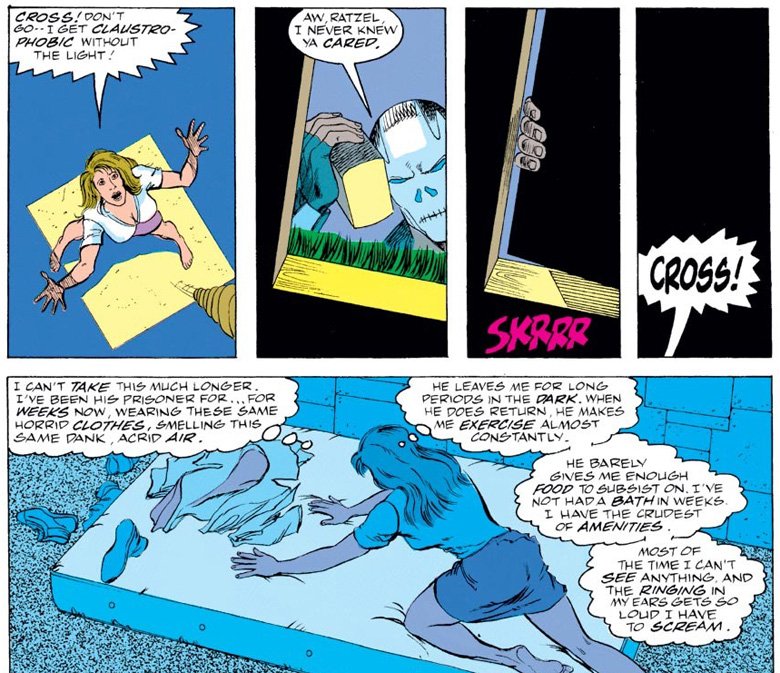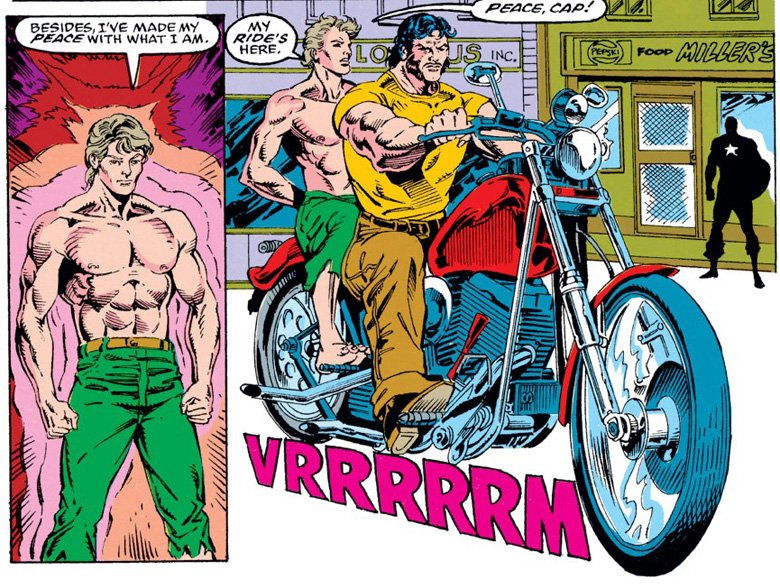That's What's Up: Remember That Time Captain America Was A Werewolf?
Each week, comic book writer Chris Sims answers the burning questions you have about the world of comics and pop culture: what's up with that? If you'd like to ask Chris a question, please send it to @theisb on Twitter with the hashtag #WhatsUpChris, or email it to staff@looper.com with the subject line "That's What's Up."
Q: Why does Capwolf rule so hard? — @WC_WIT
Okay, first things first: in the interest of full disclosure, I've been working for Marvel Comics as a freelancer for the past few years. I try to always be honest with my opinions about Marvel books—and, for that matter, comics put out by the Distinguished Competition—but that's something you probably need to know before you listen to me talk about why that story where Captain America turns into a werewolf for six issues and fights Cable is actually awesome, if only so that you can add the requisite grain of salt.
Don't get me wrong, it's weird as all hell and it's certainly not the best Captain America story ever printed, but much like that story where Thor gets turned into a frog for a couple issues, it's often brought up as a goofy bit of silliness that probably shouldn't have happened—and much like that Thor story, that's a reputation it definitely doesn't deserve. So trust me on this one: that story where Captain America turns into a werewolf for six issues and fights Cable? It's actually awesome.
Mark Gruenwald
And honestly, a lot of that has to do with Mark Gruenwald. That's not to diminish the artists who worked on "Man and Wolf," Rik Levins and Danny Bulanadi, but Gruenwald is absolutely the main draw here, if only because this story comes from a time when "Mark Gruenwald" and "Captain America" were virtually synonymous.
He was, after all, the writer of that comic for ten years, taking over from Mike Carlin with Cap #307 in 1985 and staying on the book until he handed the reins to Mark Waid in 1995 with #444, a little less than a year before his death. It's one of those legendary long runs that you saw a lot from writers at Marvel back then, like Chris Claremont on X-Men or Larry Hama on G.I. Joe, and it stands as a testament to just how good Gruenwald was at building out an entire new world for Cap.
In that time, he missed one issue—#423 was a fill-in by Roy Thomas about Cap's first meeting with the Sub-Mariner—and as you might expect from a run that spanned a decade, he introduced a ton of new characters and concepts. Characters like Crossbones, Diamondback, U.S. Agent, and Flag-Smasher (the leader of my favorite acronymic organization in the Marvel Universe, the Underground Liberated Totally Integrated Mobile Army To Unite Mankind) all made their first appearances under Gruenwald, and he also came up with the idea of the Red Skull transferring his mind into a clone of Steve Rogers' body.
And despite the fact that you occasionally got stuff like "Streets of Poison"—a surprisingly heavy-handed anti-drug story that finds the extremely drug-enhanced Captain America having to wear a suit of '90s-ass power armor—the ten years he spent on that book consistently produced amazing stories. That "Acts of Vengeance" issue where Magneto shows up to beat Red Skull down and throw him in a hole to die slowly as revenge for his participation in the Holocaust? That's Gruenwald and Kieron Dwyer in #367, one of the best issues of the best Marvel crossover ever.
Squadron Supreme: Marvel's Watchmen
But even though he was once officially named as "The Patron Saint of Marveldom" in the pages of the comics, Gruenwald was also huge fan of DC, and even broke into the industry through a fanzine where he chronicled the adventures of the Martian Manhunter. That led to what might be his most enduring creation, outside of his contributions to the larger Cap mythos: 1985's Squadron Supreme, by Gruenwald and Bob Hall.
In the same way Roy Thomas created the Invaders as Marvel's equivalent to the Golden Age Justice Society of America, the Squadron was Gruenwald's take on the Justice League of America, with an exploration of what would happen if superheroes tried so solve all of the world's real problems rather than just focusing on supervillains and alien conquerors. It's often overshadowed by other "grown-up" superhero stories from the mid-'80s, but I'll tell you right now, that thing's every bit as good as Watchmen, and paved the way for countless modern stories.
That doesn't have a lot to do with Captain America's brief experimentation with lycanthropy, but it does illustrate one of Gruenwald's defining characteristics: that dude loved comic books. So much so, in fact, that when he died, his ashes were mixed into the ink for the first printing of the Squadron Supreme paperback. And you could see that love coming through all of his stories, especially when they got a little strange.
The Bloodstone Hunt
Yes, that says "Teen Cap." It's a long story.
While he definitely tackled the book with a specific mandate to give Captain America his own set of enemies that wouldn't work for any other character, Gruenwald was pretty fond of delving into the more obscure corners of the Marvel Universe too. And that makes a lot of sense when you find out how much that dude loved all the bits and pieces that make the universe work.
In addition to his writing and editorial duties, he was well known as Marvel's "Keeper of Continuity." He was the guy who developed the exhaustive Official Handbook of the Marvel Universe, and had a memory for detail so sharp that Walt Simonson staffed the Time Variance Authority—an extradimensional organization tasked with monitoring the Marvel Universe for "anomalies"—with rows and rows of Mark Gruenwalds.
Because of that—and because you can only do so many Cap vs. Red Skull stories when you're on a book for ten years—Gruenwald often sent Cap into territory you might not expect from the Avengers' resident super-soldier. There was "The Bloodstone Hunt," for instance, which revolved around a mystical gem that gave a monster-hunting caveman superpowers and paved the way for his daughter, Elsa Bloodstone, to eventually take up residence in Nextwave: Agents of Hate.
Blood on the Moors
It's worth noting that Capwolf and "The Bloodstone Hunt" weren't the first times that Captain America went up against the supernatural, either. It might be a little unexpected, but Cap has always lent himself really well to the occasional stories of haints and spooky stuff. Roger Stern and John Byrne's "Blood on the Moors," for example, has Cap fighting a Nazi vampire called Baron Blood in a story that introduces a new version of Union Jack, and that's one of the best Cap stories ever. Throw in the fact that Gruenwald was already playing with a little bit of weirdness by having the Red Skull found a cult called the Sisters of Sin, and you've got a hero that doesn't shy away from getting into some ghostly weirdness.
Part of that comes down to Cap's adaptability as a character. He's someone who can work equally well punching out the Red Skull's neo-Nazis, going toe-to-toe with the sci-fi minions of Arnim Zola, or even standing up to Thanos in the depths of space. As long as those core ideals at the heart of his character are intact, as long as he's willing to stand up against tyranny and injustice in any form, it all works.
But there's another part that has to do with how the Marvel Universe is built with this weird little streak of horror that sneaks in among the superheroes. It's always been there, dating back to the way the earliest Spider-Man and Fantastic Four issues are structured like the monster comics that all those creators were working on in the late '50s, but by the time the Bronze Age rolled around, it was an indelible part of the universe. This is a world where a comic starring Dracula ran for 70 issues, but where it was also structured as a superhero comic. There's an idea within the fabric of the universe that stuff like Draculas and Wolfmen absolutely exist, just as long as they abide by the rules governing the larger superhero world around them.
Which brings us back around to Capwolf.
Man and Wolf
My favorite thing about "Man and Wolf," to use the story's actual title, is how well it blends the entire Marvel Universe into an adventure that definitely feels like a weird couple of days for Cap, but a completely logical sequence of events for the world in which he lives.
No, wait. That's a lie. My favorite part is that it's about Captain America being turned into a friggin' werewolf, but that probably goes without saying. That other stuff's true, though, and it really becomes apparent once you read the story in the context of the issues around it.
Right before "Man and Wolf," Cap and the Avengers had just been through a huge crossover story that, because this is 1992 and the Gulf War was still in the news, was called "Operation Galactic Storm." It's a massive, 19-part epic that pretty much ends with the Avengers sending an assassination squad after the Supreme Intelligence to effect a regime change... in space.
Compared to that, six issues as a werewolf doesn't really seem that weird, but it does provide an interesting setup. After being unable to talk the rest of the Avengers out of what I believe might have technically been a war crime, he's left wondering if he really needs to be a part of the team, and has a crisis of faith that ends with a discussion with Tony Stark about wartime morality—in which, by the way, Tony Stark explains the nature of war to Actual Soldier Captain America.
It's a pretty heavy setup, but it all leads to Cap deciding to take care of some things he was neglecting while he was in space. Which, in this case, specifically means finding out where his personal pilot, Hero Astronaut and Occasional Werewolf John Jameson, has been for the past month.
Hero astronaut (and occasional werewolf) John Jameson
That's one of the things that makes it great. There's this weird connection there, rooted in the idea that the universe is so cohesive that Spider-Man's boss's son—who is incidentally a werewolf because he went to the moon and picked up a rock one time—can be Captain America's personal pilot, and that his own history can wind up getting Cap into the kind of adventure that you'd never expect.
Which is exactly what happens here. The whole thing winds up being a plot of Dredmund the Druid, who—in a tribute to Gruenwald's love of obscure bits of trivia—was a villain who'd made his debut in a story where he tried to use magic to kill Nick Fury, and hadn't been seen for 146 issues at this point. After teaming up with Dr. Nightshade, another relatively obscure villain, he decided it would be a good idea to turn an entire town in Massachusetts into werewolves, and use John Jameson's mystical Moonstone to become... the ultimate wolfman.
It is an amazing plan, for every definition of that word.
Starwolf!
Naturally, Captain America gets involved—it's his name on the cover, after all—but he's not the only one. Another great quirk of the story that plays off the idea of a larger universe is this idea that the mystical werewolf energies involved in turning Dredmund into STARWOLF are also inexorably drawing anyone who even seems sort of werewolf-like to the area.
Jack Russell, Werewolf by Night, shows up, and so do Wolfsbane from X-Factor and Feral from X-Force, but it doesn't stop there. By the end of the story, Cable has shown up looking for Feral, and, because this is 1992, Wolverine is also there.
Capwolf, Wolverine, and Cable, together at last
Fun fact: wolverines are not actually wolves. I've done some reading and it turns out they are an entirely different animal. Not that you'd know it from that one movie where someone insists that wolverines howl at the moon instead of, you know, just sort of grunting like a badger.
Anyway, while it's loaded up with guest stars—and while we haven't even talked about Zachary Moonhunter, the antagonist who looks like the Predator and introduces himself to Cap by shooting him in the chest with a shotgun, only to be rewarded at the end of the story by becoming Cap's new pilot—the main draw here is obviously the part where Captain America himself gets dosed up with wolfman juice and winds up becoming a werewolf. And here's the thing: it's goofy as hell. I know it, you know it, Mark Gruenwald and Rik Levins know it. Even Captain America knows it, and he's the guy in the story getting turned into a wolf.
But the thing that Gruenwald understood—the same thing that all the great comics storytellers understand—is that the silliest, goofiest thing in the world can work just fine in comics, as long as you treat it like it's serious. Not "serious" in that it's grim and cheerless, but "serious" in that you apply the same rules and laws to this story that you would to anything else.
The speech
That's what makes it work for Captain America. There's this idea in superhero comics about what characters' real powers are, and for Cap, it's always been that he works as an inspirational figure. It's not just those moments of punching out fascists that make him who he is, although those are definitely great. It's that he always says the right thing, that he's able to stand up and inspire others with a stirring speech. It's definitely an aspect of his character that makes him hard to write, but it's also a very important one.
Gruenwald not only gets this, he allows it to persist, even when Cap becomes a werewolf. Even when his mind is recovering from being turned into a wolfman, when he can barely speak because his body is still used to having human vocal cords, he still gives an inspirational speech. He rallies a bunch of other imprisoned werewolves by growling his way through a speech about freedom and unlawful imprisonment so they can form a human pyramid to escape the "punishment pit."
Seriously: go back and read that last sentence again. It is buck wild, but the way that it's told, it all makes sense in the context of the story. Of course Captain America would have an astronaut who walked on the moon as his personal pilot, and of course going to the moon in the Marvel Universe means you're going to be turned into a magic werewolf, and of course those two facts would end up colliding in the strangest way possible. And also Dr. Druid is there.
Now here's the weird part.
Meanwhile: Diamondback
While all that's going on in the main story, the last few pages of every issue are devoted to a story about Diamondback, Cap's former supervillain and mostly unrequited love interest whose hot pink undercut was literally decades ahead of its time.
At this point in the story, she, like John Jameson, had been missing for quite some time, but her side of the story wasn't a weird, goofy romp with mysticism and werewolves. Instead, she was kidnapped by Crossbones and held hostage, starved, and given brutal "combat training," all designed to break her so she'd become loyal to Crossbones and serve as a "gift" to get back into the Red Skull's good graces. At the same time, readers get to see the Skull's organization, and the unsurprising, but still upsetting, cruelty that he shows to his mistress, Mother Night.
It's a much more serious side to the story, and it's a lot more in line with the superheroic high drama readers might be expecting from their comics than Captain America rallying werewolf patriotism. But what makes this story so enjoyable is that none of it seems out of place alongside the other. There's a tonal shift, but the fact that we're seeing a plot for werewolf world domination doesn't make Diamondback's ordeal seem frivolous, and going back and forth between her story and Cap's doesn't feel like whiplash, either.
That's what makes this story work.
Werewolf by Night and his motorcycle pal
Well, that and the fact that it ends with Werewolf By Night just cold hopping on some dude's motorcycle, shirtless and shoeless, and riding away with no explanation. But now that I look at it—and knowing Gruenwald's love of the obscure, I'm pretty sure that's actually Wolf from Team America, the short-lived comic about super-powered motorcycle stunt riders who could unwittingly summon a mysterious Black Rider who had their combined dirtbike talent.
Comics are great, y'all. Comics are great.
Each week, comic book writer Chris Sims answers the burning questions you have about the world of comics and pop culture: what's up with that? If you'd like to ask Chris a question, please send it to @theisb on Twitter with the hashtag #WhatsUpChris, or email it to staff@looper.com with the subject line "That's What's Up."
